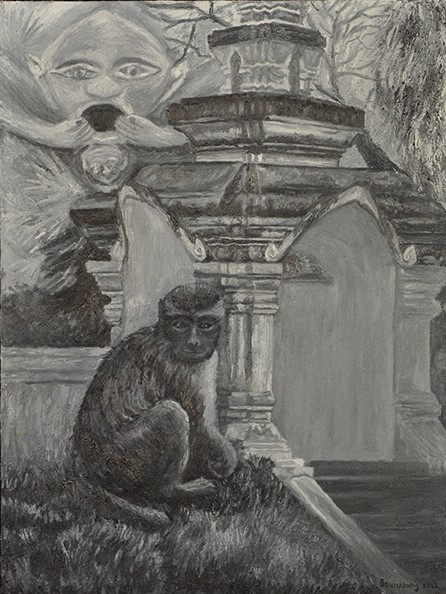ບຸນຄົງສົນໃຈໃນການແຕ້ມຮູບມາແຕ່ຄາວຍັງນ້ອຍ…ໃນສະໄໝຮຽນຢູ່ຊັ້ນປະຖົມ, ລາວມີຄວາມຫຼົງໄຫຼໃນກາຕູນຄອມມິກສ໌ ແລະ ພາບກາຕູນ, ເຮັດໃຫ້ລາວໄດ້ແຕ້ມຮູບດັ່ງກ່າວລົງໃນປຶ້ມບັນທຶກ. ລາວມີຄວາມເຂົ້າໃຈໄດ້ຢ່າງວ່ອງໄວວ່າ ລະບຽບວິໄນນີ້ມີຄວາມສໍາຄັນຕໍ່ຊີວິດເຊິ່ງຈະເຮັດໃຫ້ຕົນສາມາດກາຍເປັນນັກສິລະປິນໄດ້… ດັ່ງນັ້ນ, ດ້ວຍການອາໄສຖ່ານໄຟດໍາ ຫຼື ສີຕ່າງໆ, ວິທີການຮ່າງພາບແຕ້ມ ແລະ ແຮງບັນດານໃຈທີ່ໄດ້ພົບຈາກຊີວິດປະຈໍາວັນ ທັງໝົດນີ້ຄືວິທີທີ່ລາວຕ້ອງການຢາກຈະຖ່າຍທອດປະສົບການ ບວກກັບຄວາມເປັນຫ່ວງເປັນໃຍຜ່ານຜົນງານສິລະປະ. ບຸນຄົງສະຫຼຸບຕື່ມວ່າ: ສິລະປະໃນແງ່ມຸມຕ່າງໆເຫຼົ່ານີ້ສໍາລັບລາວນັ້ນ ແມ່ນສາມາດສະແດງອອກເຖິງຄວາມຮັບຮູ້ ແລະ ຮູ້ສຶກວ່າຈໍາເປັນຕ້ອງໄດ້ແບ່ງປັນຮ່ວມມກັນ.
Bounkhong Onsiyom
Like many artists, Bounkhong was a young child when the need to draw manifested itself. At primary school, among all activities, drawing which held the most attention for him was where he also developed the greatest aptitude.
Passionate about comics and cartoons, he filled his school notebooks with sketches and drawings of his favorite characters drawn with color pencils.
since these childhood moments, the practice of drawing has continued to gain importance in his daily life. Every day as soon as he wakes up, he draws. He firmly insists that art is his life, but he specifies – lucidly and ironically – that earning a living is another art.
So, when he discovers an daily scene that he wants to sketch, any piece of paper will be enough for him to capture this moment, it will not necessarily be an artwork, he explains, but an element of inspiration or reflection for a future painting or one in progress. His main inspiration is himself, what he faces in his daily life especially all the miserable experiences. He takes these life teachings to heart and strives to improve his work to go ahead. Sometimes, he goes back to see old pictures, drawings he did and then he adjusts to the world’s present, embellished with external pictorial sources, which he imitates or interprets.
During 2021, Bounkhong travelled for a long journey through Laos, from north to south with an artist friend (see: Calling Home, Kong Lee/Bounkhong Onsiym, published by i:cat gallery & pha tad ke, 2023). He explains that at art school, teachers taught him how to sketch for drafts, however he saw that just only as a basic technique, but during this trip, he began to appreciate sketching to the point of appropriating it and making it one of his art styles.
Therefore, he likes these simple minimalist lines but whose simplicity manages to express all the complexity of a scene to emphasize its essentials. with these lines, he wishes to tell his life, his environment, project everyday experiences into his art, but also to highlight, to alarm through art the heavy subjects that our current society must face.
Art, in these different aspects, can also be an expression of awareness and he wants to share the feeling and the need to share it collectively.





